中考英语复习语法专题---非谓语动词
图片预览



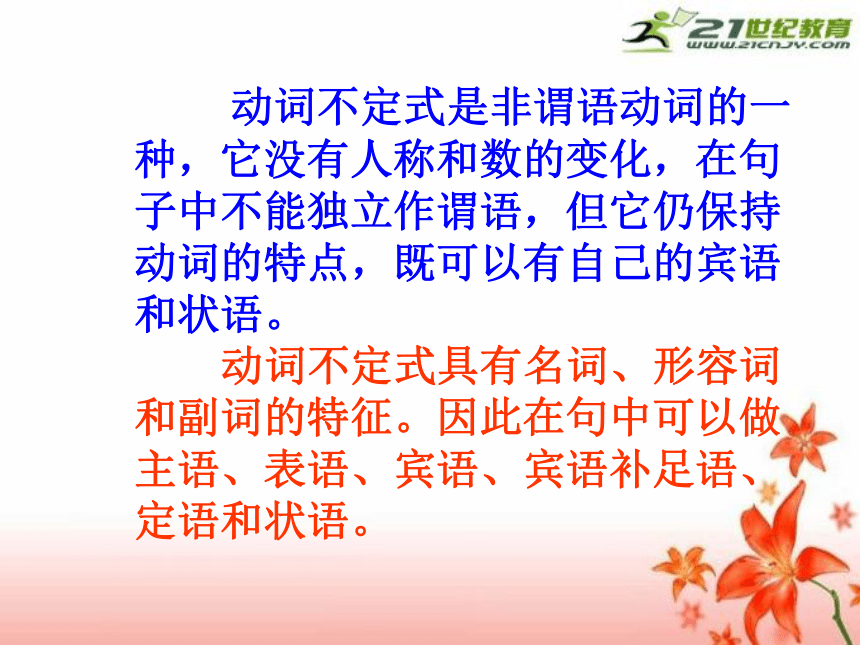

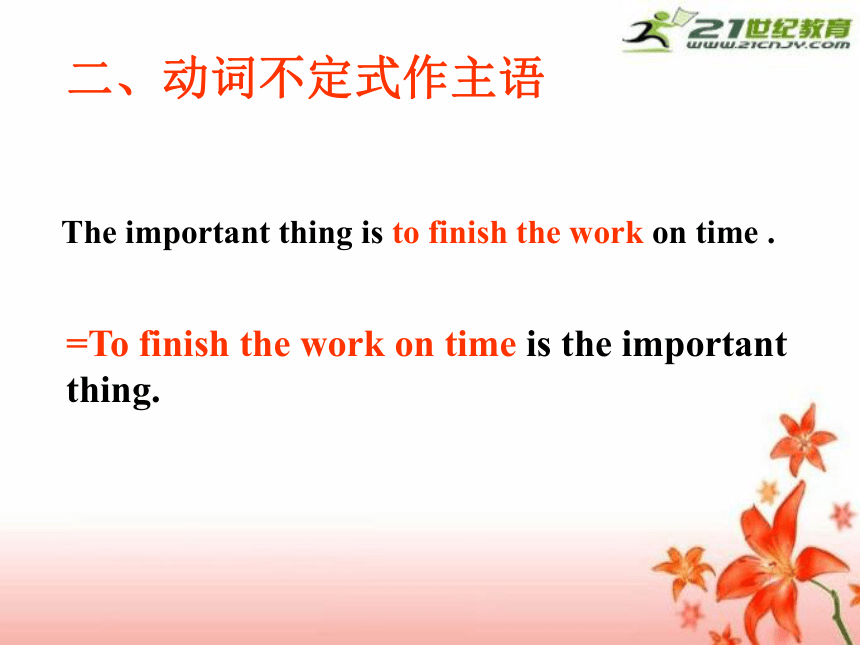

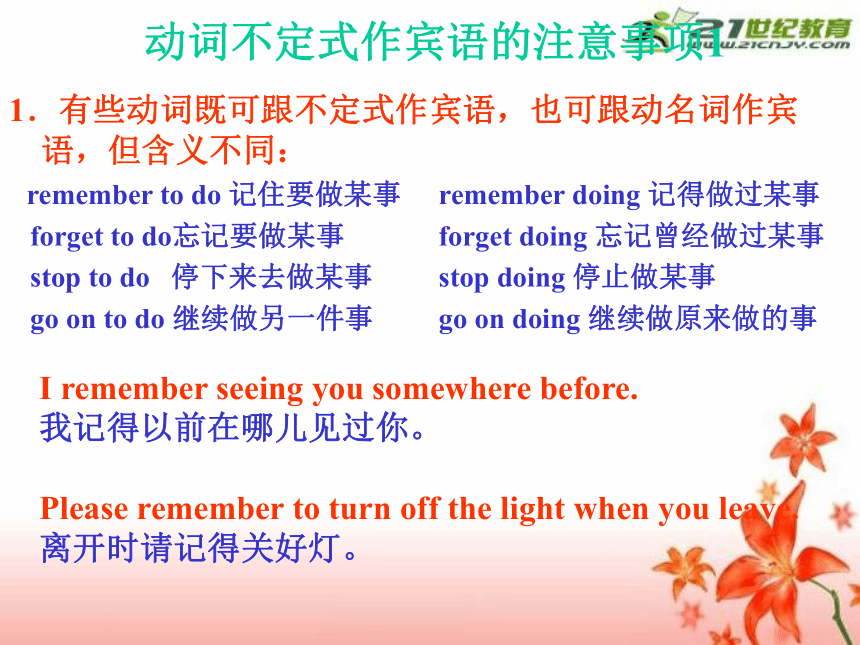

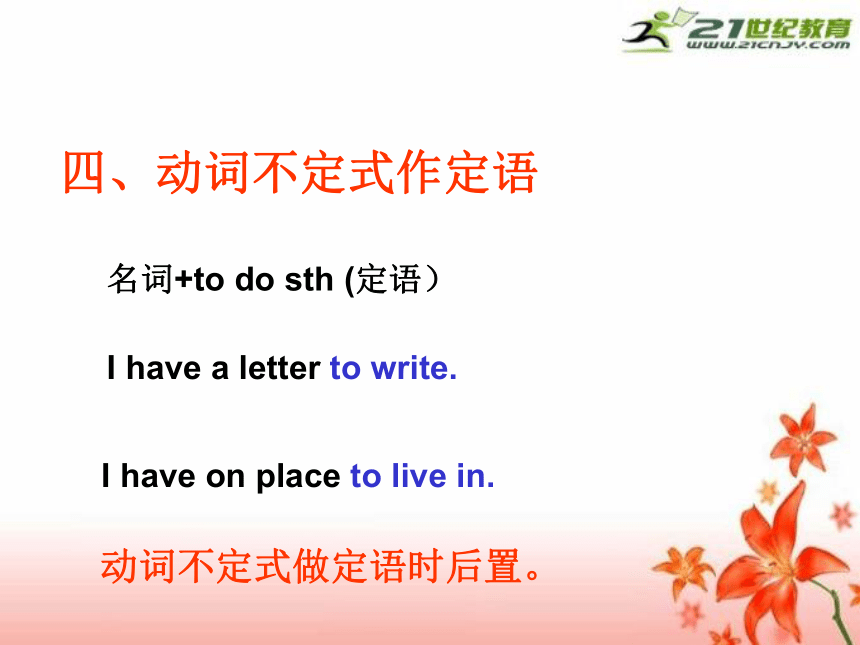

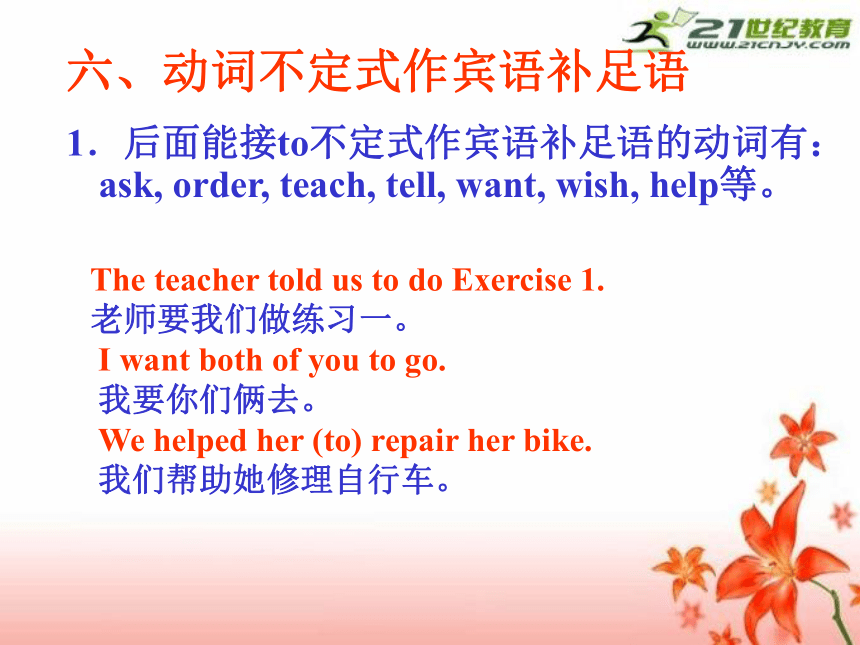
文档简介
(共42张PPT)
非谓语动词
动词不定式
动名词
分词
动词不定式是非谓语动词的一种,它没有人称和数的变化,在句子中不能独立作谓语,但它仍保持动词的特点,既可以有自己的宾语和状语。
动词不定式具有名词、形容词和副词的特征。因此在句中可以做主语、表语、宾语、宾语补足语、定语和状语。
To learn a foreign language is not easy .
注意:不定式短语作主语如果太长,常用IT作形式主语,将不定式后置。除动词be外, 动词take,cost也常用于上述结构。
一、动词不定式作主语
To teach students English is my job.
= It’s not easy to learn a foreign language.
=It is my job to teach students English.
The important thing is to finish the work on time .
二、动词不定式作主语
=To finish the work on time is the important thing.
后面能接不定式作宾语的动词有:agree, ask, choose,
decide, forget, hope, learn, want, wish, would like等。
三、动词不定式作宾语
We hope to get there before dark.
我们希望天黑以前到那儿。
The girl decided to do it herself.
那个姑娘决定自己做那件事。
动词不定式作宾语的注意事项1
1.有些动词既可跟不定式作宾语,也可跟动名词作宾语,但含义不同:
remember to do 记住要做某事 remember doing 记得做过某事
forget to do忘记要做某事 forget doing 忘记曾经做过某事
stop to do 停下来去做某事 stop doing 停止做某事
go on to do 继续做另一件事 go on doing 继续做原来做的事
I remember seeing you somewhere before.
我记得以前在哪儿见过你。
Please remember to turn off the light when you leave.
离开时请记得关好灯。
动词不定式作宾语的注意事项2
2.不定式作宾语时,如带有宾语补足语,则要把不定式放到后面,用it作形式宾语,构成“主语+动词+it+宾补(形容词、名词)+不定式”结构。如:
He found it very difficult to get to sleep.
他发现很难入睡。
I have a letter to write.
I have on place to live in.
名词+to do sth (定语)
四、动词不定式作定语
动词不定式做定语时后置。
1. I’m pleased to meet you.(原因状语)
五、动词不定式作状语
3. I went to the station only to find the train
had gone. (结果状语)
2. To get married, I need a job. (目的状语)
1.后面能接to不定式作宾语补足语的动词有:ask, order, teach, tell, want, wish, help等。
六、动词不定式作宾语补足语
The teacher told us to do Exercise 1.
老师要我们做练习一。
I want both of you to go.
我要你们俩去。
We helped her (to) repair her bike.
我们帮助她修理自行车。
2.使役动词let, have, make及感官动词see, watch, notice, hear, feel等要以不带to的不定式作宾补。
Let’s have a rest. 我们休息一会吧。
I saw him come in. 我看见他进来了。
感官动词后既可跟不带to的不定式作宾补,也可跟v-ing作宾补,前者表示动作的全部过程已结束;后者表示动作正在进行。在被动语态中跟带to的不定式。
I saw him come downstairs.
我看见他下了楼。(说明他下楼了这件事)
I saw him coming downstairs.
我看见他在下楼。(说明他下楼时的情景)
动词不定式的否定式是在to前加not;不带to的
不定式则在动词前加not. 如:
六、动词不定式的否定形式
Zhang Ming asked me not to stay at home all day.
张明要我不要整天呆在家里。
My mother let me not do it by myself.
妈妈让我不要独自做这件事。
不定式可以与what , which , how ,where ,when ,whether ,
等连用,构成不定式短语,在句子中可作主语、宾语、表语、状语、宾语不足语等。
七、不定式和疑问词连用
How to use the computer is the question (主语)
I tell him what to do . (宾语)
The question is when to start .( 表语)
基本形式
特点
动词原形 + ing
1、具有名词、动词的一些特征。
2、有时态和语态的变化
用法
1、作主语
Picking apples is much better than having classes.
2、作宾语
(1)只能接动名词做宾语的动词有miss, finish, mind, keep, practice, enjoy, 等。
(2)既可接动词不定式又可接动名词作宾语的动词有两类:
意义区分不大:begin , start, like, love, hate, prefer 等。
意义不同:remember, forget, stop, go on , try 等
3、作表语
His favorite sport is playing basketball .
4、作定语
shopping basket finishing line
购物篮 终点线
1、动名词的 复合结构为:
名词所有格
形容词性物主代词
+ 动名词
Do you mind _________the window
me to open b. I open
c.my opening d. mine opening
c
2、动名词的习惯用语:
a. It’s no use doing sth.
b. can’t help doing sth.
c. feel like doing sth.
d. be busy doing sth.
e. No doing
分词是一种动词的非谓语形式。它是由动词 +ing 或 动词 + ed 构成,它在句中起形容词或副词的作用,可以作定语,表语,状语。如:working,worked,washing,washed.
分词概述
分词可分为现在分词和过去分词两种,现在分词的形式同动名词一样,在动词后面加 ing 。而过去分词的形式则在动词后面加 ed. 分词在句中可作定语,状语或表语。
China is a developing country.
中国是一个发展中国家。
He girl singing for us is ten years old.
给我们唱歌的女孩十岁了。
There is nothing interesting.
没什么有趣的事。
作定语的分词要放在被修饰的名词之前,如果是分词词组则放在被修饰的名词之后, 如被修饰的名词是 something, anything, everything, nothing 等,分词放在被修饰名词的后面。
一、分词作定语
分词和动名词都可以作定语,判断是分词还是动名词,可以根据它们和被修饰词有无逻辑上的主谓关系来判断,有主谓关系的是分词,否则判断为动名词。
a swimming girl 游泳的女孩。(分词)
a swimming pool 游泳的池子 (动名词)
注意!
Being a student, he likes to help others.
作为学生,他喜欢帮助别人。
She is there waiting for us.
她在那儿等我们呢。
The story is interesting. 故事有趣。
The glass is broken. 玻璃杯破了。
二、分词作状语
三、分词作表语
I saw him walking in the street.
我看见他在街上走。
We found the boy sleeping.
我们发现小孩睡着了。
四、分词作宾语补足语:可以跟宾语补足语的谓语动词有 see, watch, hear, set, keep, find, have, get 等词。
I have my hair cut.
我理发了。(是别人给我理发)
She has her bike repaired.
她把自行车修理了。(别人修理的)
注 意:
have 后面的宾语补足语用过去分词常表示动作不是句子的主语发出的,而是由别人做的。
Not knowing what to do next, she stopped to wait. 不知道下一步干什么,她停下来等着。
分词的一般时表示动作同谓语动词的动作同时发生或之前发生。
Coming into the room, he lied on his bed.
回到家后,他就躺在床上。
分词的完成时表示的动作在谓语动词的前面发生。
Having had my supper, I went out for a walk.
晚饭后,我出去散步了。
五、分词的否定形式not + 分词
六、分词的时态
The building being built will be completed next year.
正在建设的大楼明年完工。
七、分词的被动形式
分词的被动形式表示分词动作同所修饰的名词有一种被动关系。
1. I didn’t spend al the money _________(buy) the books.
2. Do you have anything ________(say) at the meeting
3. Yesterday I saw a wallet ________(lie) on the ground .
4.The man ran out ________(see) what was wrong .
5. She was often heard _________(sing) in English.
6. Stop ________(read), please. I’ve something to tell you .
7. The boy _______(call) Li Hua in the room is his brother.
buying
to say
lying
to see
to sing
reading
called
1. Thank you for us so well .
A. to teach B. teaches
C. taught D. teaching
2. I often do some on Sundays.
A. washed B. to wash
C. washing D. washes
3. The boy Jack in Class One is my brother.
A. call B. to be called
C. calling D. called
4. It often takes me half an hour home.
A. Walking B. to walk
C. walked D. walks
5.Don’t forget her clean water every day .
A. to give B. giving
C. given D. give
6. I think it is important English well .
A. learning B. learn
C. to learn D. learned \
7. The funny story made us all hard .
A. laugh B. to laugh
C. laughing D. laughed
8. Our teacher told us hard at our lessons .
A. to work B. work C. working D. worked
9. Could you tell me______this newspaper
A. to read how B. how to read
C. what to read D. what read
10. I don’t know________next .
A. what to do B. what to do it
C. how to do D. to how do it
11. My hair is too long , so I must have it__this afternoon.
A.cut B. cuts C. cutting D. cutted
12. Remember ______ last for class again .
A. not to B. be not to
C. not to be D. not to coming
13. Mr Smith asked the man_____the queue .
A. not jump B. didn’t jump
C. not to jump D. to not jump
14.Why not with us You see , it’s very .
A. go ; interested B. go; interesting
C. to go ; interested D. going ; interesting
15.– What about to the cinema tonight
--That’s a good idea. I’d like with you .
A. going ; going B. to go ; to go
C. going ; to go D. go ; going
16.Everyone here is busy read for the coming entrance tests .
A. get B. to get C. getting D. gets
17.We’ve worked for two hours . Let’s a rest .
A. stop to have B. stop having
C. to stop to have D .stopping having
18. Would you mind me a favour(恩惠)?
A. do B. to go C. doing D. did
19. Mr Wang asked me him .
A. help B. helps C. to help D. helping
20. Please tell Jim not late again .
A. to B. be C. to be D. be to
21.Miss Yang asked the boy , the baby was sleeping in the room .
A. to stop to sing B. to stop singing
C. stop singing D. stop to sing
22.The boy wants his father a question about the moon .
A. asking B. to ask
C. ask D. asked
23.Please don’t forget to me , will you
A. to write B. writing
C. write
24. Mother decided — Tom away from school .
A. to keep not B. keep not
C. not to keep D. not keep
25. It’s about six o’clock, Let’s — supper now .
A. stop having B. to stop having
C. stop to have D. to stop to have
26.We’d better — on the road . A car may hit us .
A. not to play B. not play
C. to not play D. don’t play
A.
27. Liu Mei helped the Turners — their tickets on the train .
A. pick B. look up C. pick up D. look like
28. I often see them — with some foreigners .
A. talk B. to talk
C. talking D. talked
29. I often see them — with some foreigners .
A. talk B. to talk
C. talking D. talked
30. He says life won’t be worth — without love .
A. live B.lived
C. living D. to live
1.
31.This morning I saw a man on the street on my way .
A. lives ; there B. lived ; to school
C. lying ; to school D. to lie ; home .
32.He has given up tennis since he was ill .
A.play B. to play C. playing D. plays
33. ----Will you come to the net bar with me
---- Sorry , My mother always tells me there .
A. not go B. not to go
C. go D. to go
34._ Do you still remember me somewhere Beijing
-- Yes ,of course . Two years ago .
A. to see B. see
C. seeing D. saw
35. Parents must warn their children — .
A. to play with fire B. not to play with fire
C. of playing fire D. playing fire
非谓语动词
动词不定式
动名词
分词
动词不定式是非谓语动词的一种,它没有人称和数的变化,在句子中不能独立作谓语,但它仍保持动词的特点,既可以有自己的宾语和状语。
动词不定式具有名词、形容词和副词的特征。因此在句中可以做主语、表语、宾语、宾语补足语、定语和状语。
To learn a foreign language is not easy .
注意:不定式短语作主语如果太长,常用IT作形式主语,将不定式后置。除动词be外, 动词take,cost也常用于上述结构。
一、动词不定式作主语
To teach students English is my job.
= It’s not easy to learn a foreign language.
=It is my job to teach students English.
The important thing is to finish the work on time .
二、动词不定式作主语
=To finish the work on time is the important thing.
后面能接不定式作宾语的动词有:agree, ask, choose,
decide, forget, hope, learn, want, wish, would like等。
三、动词不定式作宾语
We hope to get there before dark.
我们希望天黑以前到那儿。
The girl decided to do it herself.
那个姑娘决定自己做那件事。
动词不定式作宾语的注意事项1
1.有些动词既可跟不定式作宾语,也可跟动名词作宾语,但含义不同:
remember to do 记住要做某事 remember doing 记得做过某事
forget to do忘记要做某事 forget doing 忘记曾经做过某事
stop to do 停下来去做某事 stop doing 停止做某事
go on to do 继续做另一件事 go on doing 继续做原来做的事
I remember seeing you somewhere before.
我记得以前在哪儿见过你。
Please remember to turn off the light when you leave.
离开时请记得关好灯。
动词不定式作宾语的注意事项2
2.不定式作宾语时,如带有宾语补足语,则要把不定式放到后面,用it作形式宾语,构成“主语+动词+it+宾补(形容词、名词)+不定式”结构。如:
He found it very difficult to get to sleep.
他发现很难入睡。
I have a letter to write.
I have on place to live in.
名词+to do sth (定语)
四、动词不定式作定语
动词不定式做定语时后置。
1. I’m pleased to meet you.(原因状语)
五、动词不定式作状语
3. I went to the station only to find the train
had gone. (结果状语)
2. To get married, I need a job. (目的状语)
1.后面能接to不定式作宾语补足语的动词有:ask, order, teach, tell, want, wish, help等。
六、动词不定式作宾语补足语
The teacher told us to do Exercise 1.
老师要我们做练习一。
I want both of you to go.
我要你们俩去。
We helped her (to) repair her bike.
我们帮助她修理自行车。
2.使役动词let, have, make及感官动词see, watch, notice, hear, feel等要以不带to的不定式作宾补。
Let’s have a rest. 我们休息一会吧。
I saw him come in. 我看见他进来了。
感官动词后既可跟不带to的不定式作宾补,也可跟v-ing作宾补,前者表示动作的全部过程已结束;后者表示动作正在进行。在被动语态中跟带to的不定式。
I saw him come downstairs.
我看见他下了楼。(说明他下楼了这件事)
I saw him coming downstairs.
我看见他在下楼。(说明他下楼时的情景)
动词不定式的否定式是在to前加not;不带to的
不定式则在动词前加not. 如:
六、动词不定式的否定形式
Zhang Ming asked me not to stay at home all day.
张明要我不要整天呆在家里。
My mother let me not do it by myself.
妈妈让我不要独自做这件事。
不定式可以与what , which , how ,where ,when ,whether ,
等连用,构成不定式短语,在句子中可作主语、宾语、表语、状语、宾语不足语等。
七、不定式和疑问词连用
How to use the computer is the question (主语)
I tell him what to do . (宾语)
The question is when to start .( 表语)
基本形式
特点
动词原形 + ing
1、具有名词、动词的一些特征。
2、有时态和语态的变化
用法
1、作主语
Picking apples is much better than having classes.
2、作宾语
(1)只能接动名词做宾语的动词有miss, finish, mind, keep, practice, enjoy, 等。
(2)既可接动词不定式又可接动名词作宾语的动词有两类:
意义区分不大:begin , start, like, love, hate, prefer 等。
意义不同:remember, forget, stop, go on , try 等
3、作表语
His favorite sport is playing basketball .
4、作定语
shopping basket finishing line
购物篮 终点线
1、动名词的 复合结构为:
名词所有格
形容词性物主代词
+ 动名词
Do you mind _________the window
me to open b. I open
c.my opening d. mine opening
c
2、动名词的习惯用语:
a. It’s no use doing sth.
b. can’t help doing sth.
c. feel like doing sth.
d. be busy doing sth.
e. No doing
分词是一种动词的非谓语形式。它是由动词 +ing 或 动词 + ed 构成,它在句中起形容词或副词的作用,可以作定语,表语,状语。如:working,worked,washing,washed.
分词概述
分词可分为现在分词和过去分词两种,现在分词的形式同动名词一样,在动词后面加 ing 。而过去分词的形式则在动词后面加 ed. 分词在句中可作定语,状语或表语。
China is a developing country.
中国是一个发展中国家。
He girl singing for us is ten years old.
给我们唱歌的女孩十岁了。
There is nothing interesting.
没什么有趣的事。
作定语的分词要放在被修饰的名词之前,如果是分词词组则放在被修饰的名词之后, 如被修饰的名词是 something, anything, everything, nothing 等,分词放在被修饰名词的后面。
一、分词作定语
分词和动名词都可以作定语,判断是分词还是动名词,可以根据它们和被修饰词有无逻辑上的主谓关系来判断,有主谓关系的是分词,否则判断为动名词。
a swimming girl 游泳的女孩。(分词)
a swimming pool 游泳的池子 (动名词)
注意!
Being a student, he likes to help others.
作为学生,他喜欢帮助别人。
She is there waiting for us.
她在那儿等我们呢。
The story is interesting. 故事有趣。
The glass is broken. 玻璃杯破了。
二、分词作状语
三、分词作表语
I saw him walking in the street.
我看见他在街上走。
We found the boy sleeping.
我们发现小孩睡着了。
四、分词作宾语补足语:可以跟宾语补足语的谓语动词有 see, watch, hear, set, keep, find, have, get 等词。
I have my hair cut.
我理发了。(是别人给我理发)
She has her bike repaired.
她把自行车修理了。(别人修理的)
注 意:
have 后面的宾语补足语用过去分词常表示动作不是句子的主语发出的,而是由别人做的。
Not knowing what to do next, she stopped to wait. 不知道下一步干什么,她停下来等着。
分词的一般时表示动作同谓语动词的动作同时发生或之前发生。
Coming into the room, he lied on his bed.
回到家后,他就躺在床上。
分词的完成时表示的动作在谓语动词的前面发生。
Having had my supper, I went out for a walk.
晚饭后,我出去散步了。
五、分词的否定形式not + 分词
六、分词的时态
The building being built will be completed next year.
正在建设的大楼明年完工。
七、分词的被动形式
分词的被动形式表示分词动作同所修饰的名词有一种被动关系。
1. I didn’t spend al the money _________(buy) the books.
2. Do you have anything ________(say) at the meeting
3. Yesterday I saw a wallet ________(lie) on the ground .
4.The man ran out ________(see) what was wrong .
5. She was often heard _________(sing) in English.
6. Stop ________(read), please. I’ve something to tell you .
7. The boy _______(call) Li Hua in the room is his brother.
buying
to say
lying
to see
to sing
reading
called
1. Thank you for us so well .
A. to teach B. teaches
C. taught D. teaching
2. I often do some on Sundays.
A. washed B. to wash
C. washing D. washes
3. The boy Jack in Class One is my brother.
A. call B. to be called
C. calling D. called
4. It often takes me half an hour home.
A. Walking B. to walk
C. walked D. walks
5.Don’t forget her clean water every day .
A. to give B. giving
C. given D. give
6. I think it is important English well .
A. learning B. learn
C. to learn D. learned \
7. The funny story made us all hard .
A. laugh B. to laugh
C. laughing D. laughed
8. Our teacher told us hard at our lessons .
A. to work B. work C. working D. worked
9. Could you tell me______this newspaper
A. to read how B. how to read
C. what to read D. what read
10. I don’t know________next .
A. what to do B. what to do it
C. how to do D. to how do it
11. My hair is too long , so I must have it__this afternoon.
A.cut B. cuts C. cutting D. cutted
12. Remember ______ last for class again .
A. not to B. be not to
C. not to be D. not to coming
13. Mr Smith asked the man_____the queue .
A. not jump B. didn’t jump
C. not to jump D. to not jump
14.Why not with us You see , it’s very .
A. go ; interested B. go; interesting
C. to go ; interested D. going ; interesting
15.– What about to the cinema tonight
--That’s a good idea. I’d like with you .
A. going ; going B. to go ; to go
C. going ; to go D. go ; going
16.Everyone here is busy read for the coming entrance tests .
A. get B. to get C. getting D. gets
17.We’ve worked for two hours . Let’s a rest .
A. stop to have B. stop having
C. to stop to have D .stopping having
18. Would you mind me a favour(恩惠)?
A. do B. to go C. doing D. did
19. Mr Wang asked me him .
A. help B. helps C. to help D. helping
20. Please tell Jim not late again .
A. to B. be C. to be D. be to
21.Miss Yang asked the boy , the baby was sleeping in the room .
A. to stop to sing B. to stop singing
C. stop singing D. stop to sing
22.The boy wants his father a question about the moon .
A. asking B. to ask
C. ask D. asked
23.Please don’t forget to me , will you
A. to write B. writing
C. write
24. Mother decided — Tom away from school .
A. to keep not B. keep not
C. not to keep D. not keep
25. It’s about six o’clock, Let’s — supper now .
A. stop having B. to stop having
C. stop to have D. to stop to have
26.We’d better — on the road . A car may hit us .
A. not to play B. not play
C. to not play D. don’t play
A.
27. Liu Mei helped the Turners — their tickets on the train .
A. pick B. look up C. pick up D. look like
28. I often see them — with some foreigners .
A. talk B. to talk
C. talking D. talked
29. I often see them — with some foreigners .
A. talk B. to talk
C. talking D. talked
30. He says life won’t be worth — without love .
A. live B.lived
C. living D. to live
1.
31.This morning I saw a man on the street on my way .
A. lives ; there B. lived ; to school
C. lying ; to school D. to lie ; home .
32.He has given up tennis since he was ill .
A.play B. to play C. playing D. plays
33. ----Will you come to the net bar with me
---- Sorry , My mother always tells me there .
A. not go B. not to go
C. go D. to go
34._ Do you still remember me somewhere Beijing
-- Yes ,of course . Two years ago .
A. to see B. see
C. seeing D. saw
35. Parents must warn their children — .
A. to play with fire B. not to play with fire
C. of playing fire D. playing fire
同课章节目录
- 词法
- 名词
- 动词和动词短语
- 动词语态
- 动词时态
- 助动词和情态动词
- 非谓语动词
- 冠词
- 代词
- 数词和量词
- 形容词副词及其比较等级
- 介词和介词短语
- 连词和感叹词
- 构词法
- 相似、相近词比较
- 句法
- 陈述句
- 一般疑问句和否定疑问句
- 特殊疑问句及选择疑问句
- 反意疑问句
- 存在句(There be句型)
- 宾语从句
- 定语从句
- 状语从句
- 主谓一致问题
- 简单句
- 并列句
- 复合句
- 主谓一致
- 主、表语从句
- 名词性从句
- 直接引语和间接引语
- 虚拟语气
- 感叹句
- 强调句
- 倒装句
- 祈使句
- 句子的成分
- 句子的分类
- 题型专区
- 单项选择部分
- 易错题
- 完形填空
- 阅读理解
- 词汇练习
- 听说训练
- 句型转换
- 补全对话
- 短文改错
- 翻译
- 书面表达
- 任务型阅读
- 语法填空
- 其他资料
